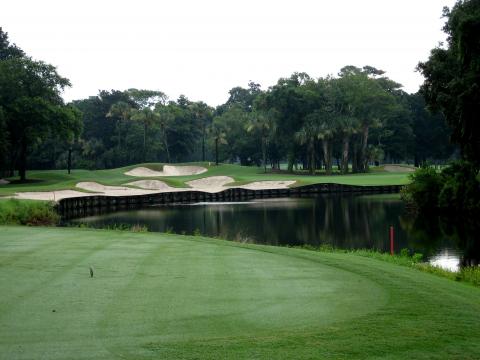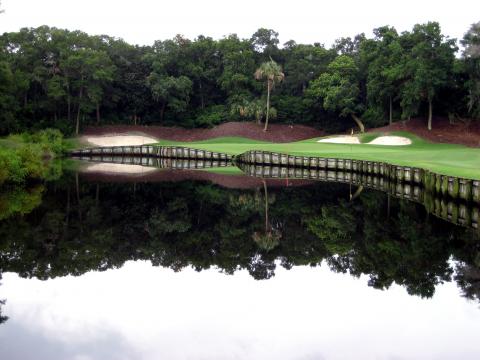"And the people played their crazy game,
With a joy I'd never seen..."
There Used to be a Ballpark Here, lyrics by Joe Raposo
I missed the Frank Sinatra era by a half-generation or so. My parents were big fans of the crooner. But one of his songs struck me personally in a way few songs of my acid and folk rock generation did. It was titled "There Used To Be A Ballpark Here." It is a sad song, filled with the pathos of loss -- loss of a favorite place but also of lost youth.
I'm thinking about that song lately as I read more and more stories about golf course closings -- some I have played, some I know by reputation and others whose stories I read with a sense of sadness, especially those that are family run and whose closings are so devastating to those who have bet the ranch -- sometimes literally their own ranches -- on success.
A few years after I went off to college, the public golf course where I learned
I didn't have nearly the same connection to the Jack Nicklaus designed Melrose Club at the Daufuskie Island Resort, but I read with sadness a few months ago that it had closed. Part of the Daufuskie Island Resort on an island
The Melrose course is not only a challenging, scenic layout along the Calibogue Sound, with views out to Hilton Head, but it is also something of a museum piece, as it shows Nicklaus' design approach at an early point, a couple of years after leaving Pete Dye's tutelage. Many of the Nicklaus signatures are in evidence, including trees in mid-fairway and a bias toward high left-to-right approach shots to greens. Most of the adjacent homes keep their fair distance from the course, and although some players might recoil a bit at the bright pastel exteriors that frame the tee boxes and fairways of a few of the finishing holes, I loved the contrast against the blue waters beyond.
One of the saddest stories I have heard about a golf course involves the formerly private, 47-year-old North Augusta Country Club, between Aiken, SC, and Augusta, GA. In 2007 one of its members and his siblings bought the club with the idea of upgrading it and adding more members. The timing, of course, could not have been worse, coming just at the beginning of the market
It is expensive to operate a golf course, and it is hard to imagine that the mom and pop courses -- like mom and pop bookstores, retail shops and pharmacies -- can survive in this Walmart world of ours. I see a trend emerging in golf course management that will certainly depersonalize the experience of playing golf but might, in other ways, turn out to be an advantage for golfers, especially those who like to play a variety of layouts. Myrtle Beach, the grand buffet of golf in the U.S. and a place that shamelessly over-built golf courses in the last two decades, is something of a laboratory for this trend. Where more than 120 courses once could sustain visiting golfers from Canada and the northern U.S., the total number of layouts is now closer to 100. Just two weeks ago, the excellent Legends courses in central Myrtle Beach were sold at auction to GE Capital, which held the note on them. Thankfully the Heathland, Moorland and Parkland courses will remain open, at least for now.
Local companies now own most of the courses in Myrtle Beach. The Classic Group, for example, owns four local courses favored
Those clubs that have remained independent have seen fit to forge marketing agreements with others. For example, Pawleys Plantation (single-owner) and Caledonia and True Blue Golf Clubs (one owner of the two of them) have created the Waccamaw Golf Trail with other local courses on the southern end of Myrtle Beach's Grand Strand. Twenty courses north of the North Carolina/South Carolina state line formed a similar trail last year. These marketing arrangements are designed to attract package players to particular areas of the Grand Strand; they are most attractive to those who hate to drive up to 45 miles from hotel to golf course.
Most intriguing of such new strategies is a push by John McConnell and others to "collect" private and semi-private courses into one group and offer memberships to all of them. The McConnell Group of Raleigh, NC, has acquired a half-dozen such courses, most in North Carolina, but they clearly have an eye on expanding toward the ocean. In June, members of the private Reserve at Litchfield Beach voted overwhelmingly to sell the 10-year old club to McConnell in exchange for his pledge not to accept public play there for at least 10 years. Alas, the deal was scotched when former members filed suit to recoup their original equity fees.
The McConnell idea is not a new one. In Atlanta, for example, the Canongate Group makes 26 courses available to members for one annual fee of less than $3,000. Many of the courses are highly rated. And then there is The Cliffs Communities, where one of the selling points to those willing to plunk down a $150,000 initiation fee is the promise of eight top-flight, totally private golf courses, including the first American Tiger Woods design at High Carolina, due to open in 2011. One may wonder how often a resident of The Cliffs at Walnut Cove near Asheville will make the two-hour round-trip journey to play the fine Tom Fazio course at Keowee Vineyard.
But if you have to ask, then you probably can't afford it.

























